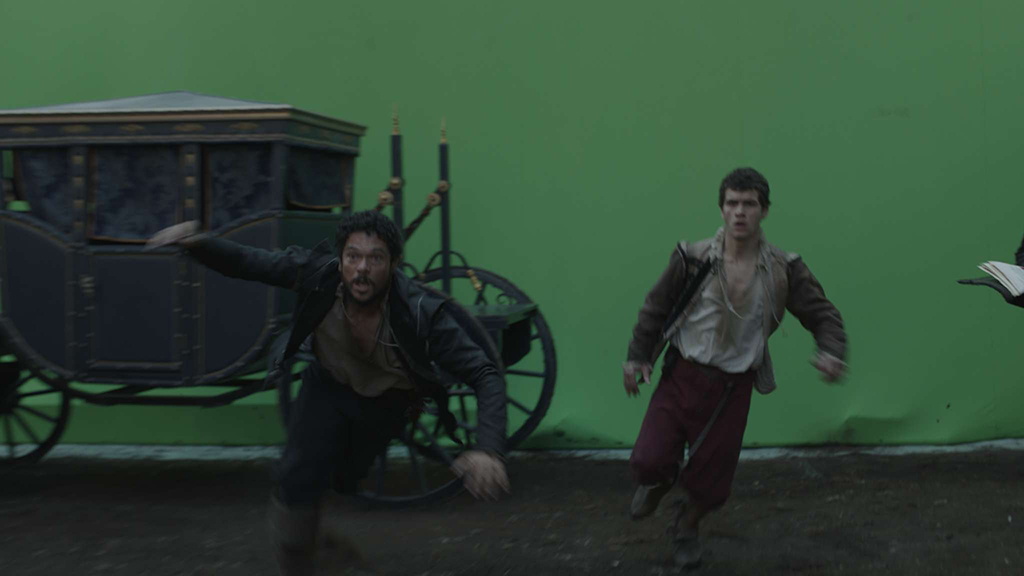By IAN FAILES
By IAN FAILES


“We ended up having an expert in 16th century Spain, not only with knowledge in visual arts, but also in other aspects we needed to know such as social behavior, urban planning, etc.”
—Juanma Nogales, Visual Effects Supervisor, Twin Pines
When Spanish telecom outfit Movistar+ set out to make an ambitious TV series set in 16th-century Seville with The Plague (La Peste), visual effects were always going to be a necessary factor. Historical accuracy was important for the show, but few locations in Spain were without modern artifacts.
The solution was to film as much in real locations as possible, and then extend and enhance these via digital environments. Madrid-based visual effects studio Twin Pines made many of these kinds of scenes possible, delivering over 500 VFX shots for the series.
VFX Voice asked Twin Pines Visual Effects Supervisor Juanma Nogales about how the shoot helped enable the later environment builds and about crafting buildings and landscapes with the right sense of time for a show set in the 1500s.
During filming of key locations in Spain, Nogales and his team spent time capturing references that would help with their later visual effects effort. “In most of the scenes that we had later intervention,” says Nogales, “we always had references of light, spherical photos with bracketing for HDRis – to help us with the lighting of the set in 3D – and photogrammetry of the set to help us with the matchmove. In some cases the photogrammetry was done with the help of drones that photographed the larger sets, such as the port or Castle of San Jorge.
“In addition, a lot of extras were scanned, previously dressed and made up in period costumes in order to have a library of digital doubles that we used both in scenes of crowds and in extensions of backgrounds of, say, people simply strolling through the streets or sailors in the boats of the port.”

“In some cases the photogrammetry was done with the help of drones that photographed the larger sets, such as the port or San Jorge Castle.”
—Juanma Nogales, Visual Effects Supervisor, Twin Pines
The principal photography and reference plates served as the starting point for Twin Pines in re-creating the architecture and environments for 16th century Seville, but there was also a major research project undertaken by Art Director Iñigo Rotaetxe. “He worked for 10 months side by side with experts in that period of history and with the art department of the series,” says Nogales. “We ended up having an expert in 16th century Spain, not only with knowledge in visual arts, but also in other aspects we needed to know such as social behavior, urban planning, etc.”
Nogales suggests that the most challenging shots in the series were those that take place in the Seville port. The location used to film these sequences only incorporated a river and a small amount of construction from the art department. But Twin Pines had to add shipyards, ships, and the city’s historic city walls, towers and buildings.


“A lot of extras were scanned, previously dressed and made up in period costumes in order to have a library of digital doubles that we used both in scenes of crowds and in extensions of backgrounds, say, of people simply strolling through the streets or sailors in the boats of the port.”
—Juanma Nogales, Visual Effects Supervisor, Twin Pines
“A sequence from episode six outside the Cathedral was also very complicated,” notes Nogales. “It was for the public trial of the Inquisition. This sequence was shot in an outdoor studio surrounded by greenscreen. As in the case of the port, we had very few physical elements built and had to generate both the surrounding architecture and the crowds attending the trial.”
Audiences might be aware that the grander port and Cathedral scenes required visual effects work, but there are plenty of other effects in The Plague which are likely to go by unnoticed. “There was a set called the noble streets, in which several sequences take place throughout the series, and that I think the audience is surprised when they know that there is intervention from VFX,” says Nogales.
“It’s really all about set extensions and digital doubles that continue in a very credible way with what was actually shot. The qualities in the textures, the lighting and the compositing make you as a viewer think that the street continues the way you see it in the series: you don’t think there is a visual trick.”


Of course, in every scene, Twin Pines’ goal was to make their digital additions completely seamless, which Nogales believes was achieved in several ways, thanks to the collaboration of a number of departments. “It’s very important to have an art department that helps us conceptually to achieve this coherence and a 3D department that can deliver this coherence in each of the backgrounds generated.
“What also helps the type of shot that is normally done in this show is movements with handheld camera that do not seem to give importance to the environment; but precisely because they do not focus attention on that background, it makes them more striking.”